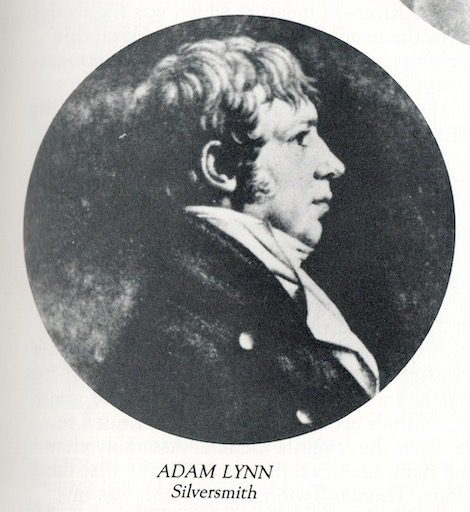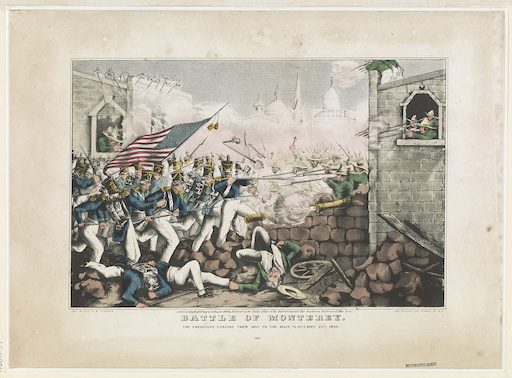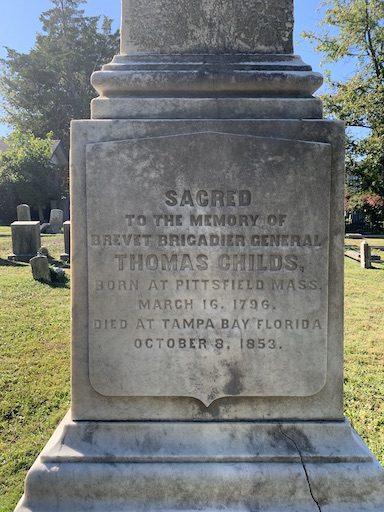Thomas Wells Childs, a courageous soldier known for his heroism during the Mexican War, rests in eternal peace at St. Paul’s Cemetery. Born on March 16, 1796, in Pittsburgh, Massachusetts, Childs’ life was marked by exceptional dedication to his country.
Having displayed a strong sense of duty and leadership potential, Childs was admitted to the United States Military Academy at West Point. He diligently pursued his military education and graduated in 1814. Recognizing his talent and commitment, he was promoted to Third Lieutenant in the 1st Artillery on March 11, 1814.
As an officer, Childs exemplified the values of honor, bravery, and loyalty. His skills were put to the test during the Mexican War, where he earned a reputation for his fearlessness on the battlefield. Through numerous encounters and perilous situations, Childs consistently displayed remarkable courage, earning the admiration of his comrades and superiors alike.
Following his illustrious military career, Thomas Wells Childs eventually found his final resting place in the solemn grounds of St. Paul’s Cemetery. His grave serves as a reminder of the sacrifices made by valiant individuals like him, who devoted their lives to defending the ideals and freedom of their beloved nation. The legacy of Thomas Wells Childs continues to inspire generations, as his name remains etched in the annals of American history.

War of 1812
Thomas Wells Childs’ bravery shone brightly during the Defense of Ft. Erie, a pivotal moment in his military career. The fort faced relentless bombardment and assault from the enemy forces between August 13th and 14th in 1814. Amidst the chaos and danger, Childs exhibited extraordinary courage and leadership, earning the respect and admiration of his fellow soldiers.
On September 17th, 1814, Childs played a crucial role in a daring and successful sortie that ultimately led to the end of the siege. His strategic acumen and unwavering determination were instrumental in turning the tide of battle in favor of the American forces.
In recognition of his exceptional contributions to the defense of Ft. Erie, Thomas Wells Childs was honored with a captured measuring tool, a quadrant. This valuable instrument was later engraved to commemorate his acts of valor and service to his country. The quadrant became a symbol of his bravery and a token of appreciation from a grateful nation.
“Presented to Lieut. Thomas Childs, by order of the President of the United States, for gallant conduct in the Sortie from Ft. Erie and for spiking the guns of the enemy’s batteries, at the age of seventeen years, Sep. 17, 1814.”
Inscription written on Quadrant given to Lieut Thomas Childs.
Childs remained steadfast in his commitment to the principles he held dear throughout his life. His legacy of bravery and selflessness continues to inspire generations of soldiers and civilians alike, reminding us of the profound impact one individual can have in the face of adversity. His memory is a testament to the indomitable spirit of those who have dedicated themselves to defending freedom and protecting their homeland.
Following the conclusion of the War of 1812, Thomas Wells Childs remained committed to his military career, continuing to serve in the United States Army. From 1818 to 1819, he was stationed at Fort Washington, Maryland, where he dutifully carried out his responsibilities as an officer.
In 1836, as tensions escalated between the United States and the Seminole Indians in Florida, Childs eagerly responded to the call of duty and joined the missions aimed at subduing the conflict. The Seminole Wars, as they came to be known, presented significant challenges for the American military as they faced a determined and resourceful opponent.
During his time in Florida, Childs demonstrated remarkable leadership and courage, leading his troops through the rugged terrain and harsh conditions of the region. His dedication to the mission and unwavering commitment to the safety of his fellow soldiers earned him the respect of his comrades and superiors alike.
After years of arduous fighting, the hostilities against the Seminole Indians finally came to an end in 1842. Childs’ contribution to the successful resolution of the conflict was recognized, and his service throughout the Seminole Wars added to his already illustrious military record.
His actions in the aftermath of the War of 1812 and during the Seminole Wars exemplified the qualities of a dedicated and honorable soldier, leaving a lasting legacy of service and bravery within the annals of American military history.
Marriage and Family
In 1819, Thomas Wells Childs found love and companionship as he married Ann Eliza Corton, the daughter of Josiah Coryton, a respected clock-maker from Alexandria. Ann Eliza had grown up in the charming town and was no stranger to the craftsmanship and dedication of her father, who had his house at 522 King Street.
Together, Thomas and Ann Eliza embarked on a journey of love and family life. They were blessed with at least seven children, each bringing joy and happiness into their lives. However, fate dealt them a heartbreaking blow as they had to endure the tragic loss of most of their children, including two baby boys, both named Henry Lynn Childs.
The middle name, “Lynn,” was a poignant tribute to the boys’ mother’s beloved uncle, Adam Lynn, Jr. A man of importance in their lives, Adam Lynn, Jr. found his final resting place in the hallowed grounds of St. Paul’s Cemetery, where his memory was cherished.
The loss of their young children was undoubtedly a source of immense sorrow for Thomas and Ann Eliza. Yet, through these difficult times, their love and resilience were the pillars that supported them, guiding them through the darkness of grief.
The bonds of family and the memories of their departed children would forever remain in their hearts, a testament to the strength of their love and the enduring power of the human spirit. In the face of life’s challenges and sorrows, Thomas and Ann Eliza found solace in each other, drawing strength from their shared journey and finding comfort amidst the cherished memories of those they had lost.

Mexican War Exploits
During the Mexican War, in 1845, Thomas Wells Childs was entrusted with commanding the Artillery Battalion. He displayed exceptional valor in the Battles of Palo Alto and Resaca-de-la-Palma, which led to his promotion to the rank of Colonel on May 9, 1846.
Action at Monterey
Subsequently, the Artillery Battalion joined General Worth’s brigade and marched towards Monterey. There, Colonel Childs received orders to attack the well-fortified heights near the Bishop’s palace. With the assistance of regular infantry and brave Texas rangers, the mission was executed with remarkable precision, and before sunrise on September 22, the Artillery Battalion’s flag was triumphantly planted on the key point of Monterey.
The following day, Colonel Childs continued to lead his soldiers in an assault on the city’s roads until they reached the main square. General Worth, impressed by Childs’ leadership and courage, lauded him, stating, “The brave Colonel Childs is safe and has achieved great success.”
The Seige of Vera Cruz & The Battle of Cerro Gorda
As General Taylor’s army received instructions to join General Scott, Childs assumed the role of Chief of Staff of Worth’s group during the siege of Vera Cruz. He actively participated in the intense military operations, demonstrating unwavering dedication to his duties.
Later, as the Major of his regiment, Childs took command of it within Twigg’s group (Twigg’s daughter and son-in-law, Abraham Myers, are buried in St. Paul’s Cemetery, too).
The valor and competence displayed by Childs and his group were evident during the Battle of Cerro Gordo on April 17-18, 1847, where they performed exceptionally well.
Military Governor of Puebla
In recognition of his distinguished service, Childs was appointed the Military Governor of Jalapa, where he continued to exhibit strong leadership and an unwavering commitment to his duties during the Mexican War. His contributions to the conflict would leave an enduring legacy, solidifying his place among the revered figures of American military history.

As the army, led by General Scott, advanced to the Valley of Mexico, Thomas Wells Childs assumed the crucial role of Military Governor in the city of Puebla, a bustling metropolis with a population of 60,000 people. Tasked with protecting the city’s hospitals, Childs faced immense challenges with a limited force of only 400 soldiers while confronting both external attacks and internal uprisings.
Amidst these daunting circumstances, Childs and his small group displayed extraordinary resilience during a siege that lasted twenty-eight days. The opposing force, led by the formidable General Santa Anna, outnumbered them significantly with over 8,000 soldiers. Yet, Childs’ unwavering determination and strategic prowess allowed them to withstand the relentless assault.
Throughout the siege, Childs and his men endured a hail of gunfire from the streets, balconies, rooftops, and even churches. Despite these overwhelming odds, they tenaciously defended Puebla, ultimately repelling the enemy’s advances and emerging victorious.
General Scott, recognizing the remarkable feat accomplished by Colonel Childs and his forces, included an official report in which he lauded their efforts. He described the defense of Puebla as a difficult, brave, and triumphant endeavor, a testament to the exceptional leadership displayed by Childs, his officers, and his dedicated soldiers.
In recognition of his exceptional service and valor during the defense of Puebla, Colonel Childs was elevated to the esteemed rank of Brigadier-General in the United States Army. This well-deserved promotion was a testament to his unwavering commitment to duty, exemplary leadership, and indomitable spirit in the face of adversity. His actions in Puebla further solidified his legacy as a revered military leader whose name would forever be etched in the annals of American military history.
Commander of Ft. McHenry
Following the conclusion of the war between Mexico and the United States, Thomas Wells Childs assumed command of Ft. McHenry in Maryland, where he served dutifully for a period of three years. His leadership and dedication ensured the fort’s continued strength and security in the post-war era.
After his time at Ft. McHenry, Childs was entrusted with overseeing military operations in East Florida. In this role, he demonstrated his expertise and commitment to the defense of the region, earning the respect and admiration of his fellow officers and soldiers.
Ft. Brooke, Florida
Tragically, on October 8, 1853, a devastating blow struck the military community when Childs succumbed to yellow fever at his headquarters, Ft. Brooke, in Florida. Yellow fever was a formidable and deadly disease, and it claimed the life of this esteemed military leader.
Childs’ passing left a void in the hearts of those who served under him and those who knew him personally. His dedication to duty, bravery, and exemplary leadership had made a lasting impact on the military, and his legacy continued to inspire others long after his passing.
Thomas Wells Childs’ name became synonymous with valor and commitment to service, as his contributions during the Mexican War and his subsequent military career were remembered and celebrated. Though he is no longer with us, his memory reminds us of the sacrifices made by those who dedicate their lives to defending their country.

| Sacred to the memory of Brevet Brigadier General THOMAS CHILDS born at Pittsfield, Mass. March 16, 1796 died at Tampa Bay, Florida October 8, 1853 | Honored as a soldier of his country for faithful services in peace and war he felt it a greater honor to be a soldier of the cross I have fought a good fight I have finished my course I have kept the faith | Commenced his military career at the sortied from Fort Erie 1814 Served with distinction through the Florida War, 1836 -41. Took a prmminent part in the Mexican War, 1846-48 and particularly in the following battles and sieges: Palo Alto Resaca de la Palma Monterey Cerro Gordo Puebla | ANN ELIZA wife of Gen’l Thos. Childs died at Acton, Sumter Co., S. C. October 29, 1875 aged 75 years |
Sources of Information
The Alexandria Association. (1956). Our Town 1749-1865 at Gadsby’s Tavern Alexandria, Virginia. The Dietz Printing Company.
Powell, M. G. (2000). The History of Old Alexandria, VA, from July 13, 1749 – May 24, 1861. Index by W. E. Pippenger. Willow Bend Books.
Miller, T. M., & Smith, W. F. (2001). A Seaport Saga Portrait of Old Alexandria, Virginia. The Downing Company Publishing.
Pippenger, W. E. (2005). Tombstone Inscriptions of Alexandria, Virginia. Volume 5. Heritage Books.
Internet Web Archives. (n.d.).Childs [Link].
The City of Alexandria Archeology Department. (n.d.). Ownership of 522 King Street. Retrieved from [link].